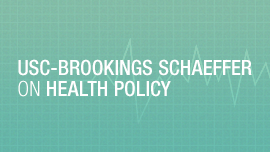This analysis is part of The Leonard D. Schaeffer Initiative for Innovation in Health Policy, which is a partnership between the Center for Health Policy at Brookings and the USC Schaeffer Center for Health Policy & Economics. The Initiative aims to inform the national health care debate with rigorous, evidence-based analysis leading to practical recommendations using the collaborative strengths of USC and Brookings.
Although the United States spends considerably more of our GDP on medical services than other developed nations, our health outcomes are no better, and in many areas, much worse. Even more significant, perhaps, is that when we look at health spending compared with spending on social services, the U.S. is a noticeable outlier. On average, nations that are members of the Organization for Economic Cooperation and Development (OECD) spend about $1.70 on social services for every $1 on health services; the U.S. spends just 56 cents.
Figure 1. Health and Social Care Spending as a Percentage of GDP 
The research on social services, health spending, and health outcomes suggests strongly that it is no coincidence that the U.S. has this unusual combination of spending and mediocre outcomes. We have the wrong balance of social and medical spending if one of our priorities is improving health overall and measures such as infant mortality and life expectancy.[1] This pattern from the international evidence is reflected in data from within our own borders. States with a higher ratio of social to health spending also have significantly better health outcomes for such conditions as adult obesity, asthma, mental health indicators, mortality rates for lung cancer, high blood pressure, and heart attack, and Type 2 diabetes.[2]
An important reason for such patterns is that in advanced countries, improvements at the margin in health tend to come more from additional investments in a good living environment and lifestyle habits than from more investments in medical services. Indeed, public health experts now agree that a variety of factors beyond access to and quality of health care influence population health. The U.S. Centers for Disease Control, for instance, estimates that health behaviors, medical care, and genes together contribute approximately 50 percent of the influence on population health, while social and environmental characteristics contribute the remaining 50 percent.[3]
This suggests a three-pronged approach to improving health in the U.S.:
- First, to improve health outcomes while actually curbing health care costs, we need to rebalance federal spending patterns. In particular, the new Administration and Congress need to adjust the current ratio of medical-to-social spending by shifting some current health care expenditures to investments in tackling “upstream” social factors with a bigger impact on health. The evidence suggests that such a shift could contribute to decreased hospital utilization, and thus reduced spending by Medicaid and Medicare, while improving health outcomes.
- The federal government should help states take the lead in this rebalancing. The best ways to rebalance and reflect local conditions and opportunities will differ from place to place, and states are the best-placed level of government to facilitate large-scale cross-sector strategies to improve health. Moreover, the research evidence on the best combination of medical and social services to improve health is not as robust as we would like. Therefore, it is important to permit much more state investigation and experimentation with re-balanced funding, combined with solid evaluation of experiments, so that states and federal policymakers can learn from each other.
- The federal government should review the evidence that social services are often the route to improved health, and agencies should work with health officials on ways to reprogram funding. A particularly promising such area for the new Administration to focus on would be housing.
Housing and Health
We do not yet have good evidence to quantify the precise connection between spending on many social services and health outcomes. The health impacts of interventions that improve economic conditions such as household income are still the subject of considerable debate. Some economists find little support to show that public transfer payments improve health outcomes,[4] while others argue that federal assistance frees family income to spend on better access to health care, and thereby improves population health.[5] Some researchers have identified evidence that stressful work environments[6] and educational disparities[7] are social mechanisms with a deleterious impact on health, but the evidence that increased public spending targeting these mechanisms will improve health outcomes is nascent.[8] In contrast, the research showing that expenditures that improve access to safe, affordable housing improve population health is relatively strong.[9]
The Federal Interagency Healthy Homes Work Group (HHWT), a collaborative that includes the U.S. Department of Housing and Urban Development (HUD), the Centers for Disease Control and Prevention (CDC), and the Environmental Protection Agency (EPA), prepared a comprehensive report documenting the shortage of safe, decent housing for families and the public health consequences of unhealthy homes in the United States.[10] This report collected evidence showing that some housing interventions addressing this shortage can have a positive effect on health outcomes, especially for disadvantaged populations.[11]
The evidence is not uniform.[12] Interventions to improve the specific conditions in dwellings for low-income families have had positive health impacts.[13] For example, studies show warmth and energy efficiency,[14] lessening mold and dampness,[15] and lead abatement[16] interventions can benefit physical health. Re-housing to improve other sub-standard conditions can improve mental and self-reported health.[17] Strong research shows that housing homeless populations significantly reduces health costs while improving health.[18] However, research also shows that relocation programs must be undertaken cautiously to avoid adverse mental health impacts associated with increased costs and displacement.[19]
Spending on housing at the community level can also have positive health effects. The social conditions in neighborhoods where people live can influence health behaviors previously considered exclusively a product of individual choice.[20] The physical features of a community’s built environment can affect whether residents smoke, eat healthy diets, feel safe enough to exercise regularly,[21] and can even influence alcohol and substance use.[22] Therefore, strategies addressing neighborhood conditions can effectively improve population health.[23]
Populations Whose Health Could Benefit from Social Spending on Housing
Access to clean, safe, and affordable housing has been identified as one of the most basic and important social determinants of good health. At least five categories of people are vulnerable to the adverse impacts of poor or badly designed housing. These are the populations whose health could improve from public spending on housing strategies:
The Homeless. Homeless Americans are more likely to experience severe and frequent mental and physical illness.[24] And in turn, chronic illness is a risk factor for homelessness.[25] As a result, homeless populations are costly utilizers of emergency, ambulatory, and hospital medical services when compared with sheltered populations. Therefore, programs that shift funds to housing programs for the homeless have a positive impact on health and health costs for this group.
Families in substandard housing conditions. These families are especially vulnerable to an increased incidence of housing-related illnesses. Numerous studies associate poor housing conditions with health problems, including asthma, lead poisoning, developmental delays, heart disease, and neurological disorders,[26] prompting some researchers to call the state of inadequate housing in poor American communities a “public health crisis.”[27] Poor rural populations are particularly susceptible to living conditions that lack basic plumbing; 30 percent of the nation’s rural housing stock lacks piped hot and cold water.[28] Two million people nationally occupy homes with severe physical problems, while 4.8 million occupy homes with moderate physical problems.[29]
Low-income families facing severe housing affordability problems. Households at greater risk for homelessness often also experience greater health risks than wealthier families due to housing instability, though the research on the causal links is still emerging. Housing instability appears also to be associated with health risks such as higher rates of behavioral and mental health issues among children,[30] increased foster care placements (triggered by parents’ inability to afford housing), alcohol dependence, domestic violence,[31] and higher rates of food insecurity among households with children.[32] The connection between housing instability and health needs more empirical investigation to understand it fully, including demonstration and pilot projects with rigorous evaluation metrics.
Families in heavily segregated, low-income housing. Research confirms the connection between racially segregated housing and poor population health.[33] In its recent study on health equity, the National Academy of Medicine drew attention to the adverse health effects of segregation and racial disparities.[34] Minorities living in cities with higher rates of residential segregation[35] experience higher infant mortality rates,[36] lower birth weights,[37] shorter life expectancy,[38] poorer mental health,[39] more coronary heart disease,[40] and greater prevalence of infectious disease such as tuberculosis,[41] even after controlling for poverty.[42] Two reasons are commonly cited: first, residential segregation increases exposure to health hazards such as air pollution; and[43] second, segregation decreases access to health-related resources. For example, segregation is associated with inferior access to health care providers, lower quality pharmacies, clinicians with inferior training,[44] and to hospitals with worse outcomes, older physical plants, and less medical equipment.[45] The association between racial isolation and poor health also affects affluent minority families, not just low-income minorities, more frequently than white families. This is because black and Hispanic households are, on average, located in neighborhoods where poverty and segregation rates are significantly higher than for white households, regardless of the family’s socioeconomic status.[46]
Importantly, some researchers have demonstrated that poverty confounds the relationship between segregated housing and poor health. Dr. Thomas A. LaVeist found that concentrated poverty, which characterizes segregated neighborhoods, is a more influential risk factor for poor self-reported health than race alone.[47] LaVeist’s results suggest that segregated populations experience poor health because they are impoverished rather than because of their race. However, Dr. Kiarri Kershaw showed that race differences in hypertension rates were largest in segregated, high-poverty areas, and smallest in integrated (i.e. non-segregated), high-poverty areas.[48] In sum, while poverty explains some but not all of the association between segregated housing and poor health, families who live in housing that is both racially isolated and located in high poverty communities could benefit from increased social spending to improve health and housing.
Elderly Americans. The housing conditions of elderly Americans, and their social, health, and other supports, are a critical factor in their mental health, physical health, and in health care costs. In general, we tend to “over medicalize” aging in America by devoting considerable resources to addressing the acute care needs of seniors – such as the results of a fall or inadequately monitored diabetes – and not enough on social and emotional supports.[49] The CDC, for instance, has found that falls among the elderly lead to enormous hospital and nursing home costs, and yet many could be avoided by focusing on home hazards, home-based monitoring, and better social supports.[50]
The Health Impact of Social Spending on Housing
Public spending to reduce homelessness is correlated with improved health outcomes generally,[51] and has been shown to be an effective investment to reduce health costs and improve outcomes for specific populations such as persons living with HIV or AIDS.
In a study of longitudinal data over 30 years across 34 OECD countries, Rand Europe found that higher levels of public social spending “seem to have a particularly strong relationship” with better health. The association grows stronger over time so that old-age spending is even more positively related to better health outcomes than other spending. Moreover, the association is strongest in societies where income inequality is greatest.[52] Figure 2 below shows the relationship between social spending categories and selected health outcomes that the Rand researchers found; the positive association between spending on housing and improved life expectancy and infant mortality rates is notable.
Figure 2. Social spending on housing is associated with longer life expectancy and lower infant mortality.
Source: Rubin, J., et al., (2016). Are better health outcomes related to social expenditure? A cross-national empirical analysis of social expenditure and population health measures. RAND Corporation.
In 1999 the U.S. Department of Housing and Urban Development launched its Healthy Homes Initiative.[53] Later, in 2009, the U.S. Surgeon General issued a Call to Action to Promote Healthy Homes.[54] Still, the United States spends less on housing services generally when compared with other OECD nations.[55] Moreover, although the U.S. government spent $190 billion in 2015 to help Americans buy or rent homes, the majority of America’s public spending on housing targets higher income households, and pays less attention to low-income families that are at greatest risk for the homelessness, housing instability, and over-crowding problems frequently associated with poor health outcomes.[56] There is considerable evidence to suggest that by re-balancing not only the overall ratio of medical-to-social spending, but also the mix of spending programs that address housing needs, the new Administration can improve and save lives for many, while reducing the cost of health care for all.
Current Federal Steps to Engage Housing to Help Address Health
The relationship between housing and health underscores the general pattern from the international and domestic research, namely that focusing heavily in medical services is not necessarily the best way to improve health. Indeed, it is often much less effective than addressing social and community conditions.
The experience of coordinating housing and health also points to the importance of engaging states in the task of redeploying resources to achieve a better balance of social and medical spending and better health outcomes. The federal government has been making extensive use of program waivers to allow states to experiment with innovative strategies to coordinate health programs with other agency programs such as the Medicaid 1115 waiver process. In addition, some agencies, such as HUD, have developed pilots and programs to explore better ways of coordinating housing and health spending to improve health, and certain HUD programs have been particularly helpful in addressing housing-related causes of poor health.
Some examples:
- Federal rental assistance programs such as Housing Choice Vouchers, Section 8 Project-Based Rental Assistance, and public housing have proved highly effective at sharply reducing homelessness and housing instability, however a large gap remains between available federal funds and the number of families whose health could be improved through rental assistance.
- Housing First has been a proven housing intervention originally designed to place chronically homeless individuals with serious mental illness in permanent supportive housing.[57] States including Florida, Oregon, and Illinois have produced evidence that the model helps to reduce emergency room and hospital inpatient utilization, shelter use, and costs to the criminal justice system, suggesting variations on the model such as increased personal accountability may also be effective in improving health and reducing health costs for broader high-need, high-cost populations. [58]
The Department of Health and Human Services (HHS), particularly using the 1115 Medicaid waiver authority, has also been helpful in fostering state-based strategies that make greater use of housing to reduce medical costs while improving health.
- Money Follows the Person (MFP) Rebalancing and The Real Choice Systems Change Grants are two demonstration programs providing effective models for Medicaid-supported housing-related activities and services, specifically for individuals transitioning out of institutions in states such as Washington and Texas.[59]
- Medicaid Research and Demonstration Programs (Section 1115) and Community-Based Services (Section 1915(c) and (i) waivers have provided funds for some states including Iowa, Michigan, North Carolina, Wisconsin, Nebraska and Ohio to use Medicaid funds to help transition individuals from institutions such as nursing homes to less costly community living arrangements.[60]
- Independence at Home Demonstration is a home-based primary care program designed to deliver comprehensive care at home to patients with multiple chronic conditions. The pilot program saved Medicare more than $10 million–an average of $1,010 per beneficiary–in 2014, its second year, according to CMS.[61]
The United States Treasury Department’s Community Development Financial Institutions Fund (CDFIF) is a spending program that provides New Markets Tax Credits to support innovative housing solutions such as financial support to developers to build affordable housing. CDFIF spending supports non-profit organizations like the Corporation for Supportive Housing (CSH) to assist communities in developing supportive housing. CSH also leverages federal funds to support state efforts nationwide through technical assistance to include pre-tenancy and tenancy-sustaining services as a part of all state Medicaid programs.[62]
How the Federal Government Can Foster Greater State-Led Rebalancing
There are significant opportunities to build on the progress and empirical evidence generated so far. The federal government’s role should be to encourage states to experiment with ways to redeploy funds to achieve better health outcomes through services provided through non-medical sectors that address the unique needs of each state’s population. States have been leaders in exploring ways in which housing interventions can improve health and reduce costs. The National Governors Association Center for Best Practices has assisted these efforts with a “Road Map for States.”[63]
The new Administration and Congress can take a number of steps to promote these efforts promoting health. For example:
Make Maximum Use of Federal Waivers
- In addition to making full use of Medicaid 1115 waiver authority, Section 1332 of the Affordable Care Act (ACA) could also be a vehicle to foster state innovation. This ACA provision allows states wide opportunities to request waivers to meet the coverage goals of the ACA. We recommend that Congress use the 1332 model to create a much broader vehicle to foster state experimentation, combined with evaluation and appropriate protections, to reach the objective of improved and more equitable health outcomes. This approach would allow states to request waivers to adapt programs and blend funds from multiple agencies and programs, including housing.
- Through demonstration waivers, allow use of public funding, such as Medicaid reimbursements, to be used for a broader range of housing support services that can be shown to achieve improved health at less federal cost. For example, states should be granted flexibility to use Medicaid funding to provide education and technical assistance, and health-related housing services, for low- and modest-income renters with chronic illnesses. Funding should encourage local media, places of worship, and local community centers to provide training and assistance.
Authorize Inter-Agency Demonstration and Pilot Projects to Gather Broader Evidence on Promising Strategies
- The new Administration should expand the evidentiary basis for state-led initiatives that will improve health through housing by launching funded pilots to test new approaches. For instance, based on collaborative research with HHS, HUD recently announced a small program to explore improved approaches to addressing health and other needs for aging Americans in HUD-assisted senior housing.[64] Focus should be on increasing inter-agency strategies using waivers and pilots. These initiatives could shed considerable light on the linkages and the interventions that might improve health outcomes, especially in areas where there is room for better understanding, such as how racial and ethnic health disparities might be addressed through improved housing and community interventions, and where improving housing affordability and coordinating health and other services could improve health outcomes.
- In addition, in coordination with HUD, HHS should widen the use of grants and pilots funded by the Center on Medicare and Medicaid Innovation (CMMI) to enable states and localities to explore broader ways in which housing and health services can be coordinated. In particular, CMMI could build on its Accountable Health Communities Model,[65] perhaps with additional funds from HUD, to accomplish this.
- The new Administration should also make it easier for state agencies to engage in quality measurement and data sharing, and to attract private funding that will sustainably finance social interventions.[66] For example, the Administration could provide improved guidance for states to navigate the Health Insurance Portability and Accountability Act ( HIPAA), the Family Educational Rights and Privacy Act ( FERPA), and other data privacy issues when developing cross-agency housing-health interventions to improve health. For instance the Administration could make greater use of guidance from the Office of the National Coordinator for Health Information.
Expand Blending and Braiding of Public-Private Funding Streams to Improve Housing and Community Development
- The new Administration should help attract private investment to distressed communities by expanding the Treasury Department’s use of tax credit incentives. For example, by financing Health Impact Assessments, federal social spending could encourage states to leverage New Market and Community Development tax credits to finance affordable housing development.
- The Administration should encourage the blending/braiding of program funds at the federal, state, county, and local level to support innovative “upstream” social program and housing investments that directly serve the objective of improving health. For example, federal support could expand programs like Oregon’s Housing with Services, a partnership of housing, health insurers, and service providers serving low-income seniors and others with disabilities in Portland, Oregon. More generally, the federal government could encourage states to adopt Maryland’s system of county-level Local Management Boards, which make it easier for federal, state, and private resources to be used together to support local multi-sector collaboration.[67]
Overall, we see ample evidence to recommend that the new Administration should allow states to rebalance the ratio of medical-to-social spending where there is evidence to show that social interventions can positively affect health outcomes. The federal government should allow states the flexibility to generate new evidence of ways that public spending can impact health in order to improve lagging U.S. health outcomes.
[1] Bradley, E., et al., (2011). Health and Social Services Expenditures: Associations with Health Outcomes, BMJ Quality & Safety. 20(10), 826-831.
[2] Bradley, E., et al (2016). Variation in Health Outcomes: The Role of Spending on Social Services, Public Health, and Health Care, 2000-09, Health Affairs 35(5), 760-768.
[3]Tarlov, A.R. (1999). Public Policy Frameworks for Improving Population Health, Ann N.Y. Acad Sci 896:281-293; Centers for Disease Control and Prevention. NCHHSTP Social Determinants of Health, available here: https://www.cdc.gov/nchhstp/socialdeterminants/faq.html
[4] Larrimore, J., (2011). Does a Higher Income have Positive Health Effects? Using the Earned Income Tax Credit to Explore the Income-Health Gradient, Milbank Q. 89(4), 694-727.
[5] Shermon, A. et al. (2013). Various Supports for Low-Income Families Reduce Poverty and Have Long-Term Effects on Families and Children, Center on Budget and Policy Priorities. Available here: http://www.cbpp.org/research/various-supports-for-low-income-families-reduce-poverty-and-have-long-term-positive-effects
[6] Siegrist, J. (1996). Adverse health Effects of High-Effort/Low-Reward Conditions. Journal of Occupational Health Psychology, 1(1), 27-41. See also, Robert Wood Johnson Foundation. (2013). How Does Employment —or Unemployment —Affect Health? Available here: http://www.rwjf.org/content/dam/farm/reports/issue_briefs/2013/rwjf403360
[7] Zimmerman, E. B., Woolf, S. H. and Haley, A. (2015). Understanding the Relationship Between Education and Health: A Review of the Evidence and an Examination of Community Perspectives, Population Health: Behavioral and Social Science Insights. Agency for Healthcare Research and Quality. Retrieved from http://www.ahrq.gov/professionals/education/curriculum-tools/population-health/zimmerman.html
[8] Filmer, D. (1999). The Impact of Public Spending on Health: Does Money Matter?, Social Science & Medicines 49:1309-1323 and 50(10):1517-1518.
[9] Krieger, J. and Higgins, D. L. (2002). Housing and Health: Time Again for Public Health Action. American Journal of Public Health, 92(5), 758–768; Raymond J., Wheeler, W., Brown MJ. (2011) Inadequate and Unhealthy Housing, 2007 and 2009. Centers for Disease Control and Prevention Morbidity and Mortality Weekly Report, 60, 21-27. Retrieved from https://www.cdc.gov/mmwr/preview/mmwrhtml/su6001a4.htm
[10] Federal Healthy Homes Work Group. (2013). Advancing Healthy Housing – A Strategy for Action. Retrieved from https://portal.hud.gov/hudportal/HUD?src=/program_offices/healthy_homes/advhh
[11] Jacobs, D.E. et al. (2010). A systematic review of housing interventions and health: Introduction, Methods, and Summary Findings, Journal of Public Health Management and Practice. 16(5), S5-S10.; National Center for Healthy Housing, (2009). Housing Interventions and Health: A Review of the Evidence. Retrieved from http://www.nchh.org/LinkClick.aspx?fileticket=2lvaEDNBIdU%3d&tabid=229
[12] Thomson, H. et al. (2001). Health Effects of Housing Improvements: Systematic Review of the Intervention Studies, British Medical Journal 323, 187-190.
[13] Marsh, A., et al. (2010). Housing Deprivation and Health: A Longitudinal Analysis, Journal of Housing Studies 15(3), 411-428; Bonnefoy, X., (2007). Inadequate Housing and Health: An Overview, International Journal of Environment and Pollution, 30(3/4), 411-429.
[14] Thomson, H., Thomas, S., Sellstrom, E., and Petticrew, M. (2013). Housing Improvements for Health and Associated Socio-economic Outcomes. Cochrane Public Health Group. Retrieved from http://onlinelibrary.wiley.com/doi/10.1002/14651858.CD008657.pub2/abstract
[15] Wilkinson, D. (1999). Poor Housing and Ill Health: A Summary of Research Evidence, The Scottish Office Central Research Unit.
[16] Gould, E. (2009). Childhood Lead Poisoning: Conservative Estimates of the Social and Economic Benefits of Lead Hazard Control, Environmental Health Perspectives, 117(7), 1162-1167.
[17] Thomson, H., Petticrew, M., Douglas, M. (2003). Health Impact Assessment of Housing Improvements: Incorporating Research Evidence. Journal of Epidemiology and Community Health, 57, 11-16. Retrieved from http://www.nchh.org/portals/0/contents/article0083.pdf
[18] The Commonwealth Fund, Quality Matters (October/November 2014). In Focus: Using Housing to Improve Health and Reduce the Cost of Caring for the Homeless. Retrieved from http://www.commonwealthfund.org/publications/newsletters/quality-matters/2014/october-november/in-focus
[19] Thomson, H., Petticrew, M., and Morrison, J. (2002). Housing Improvement and Health Gain: A Summary and Systematic Review. World Health Organization, retrieved from http://www.who.int/hia/evidence/whohia092/en/.
[20] Institute of Medicine, Committee on Health and Behavior. (2001). Social Risk Factors. Health and Behavior: The Interplay of Biological, Behavioral, and Societal Influences (87-137). Washington, DC: National Academy Press.
[21] Robert Wood Johnson Foundation Issue Brief (2008). Where We Live Matters for our Health: Neighborhoods and Health. Retrieved from http://www.commissiononhealth.org/PDF/888f4a18-eb90-45be-a2f8-159e84a55a4c/Issue%20Brief%203%20Sept%2008%20-%20Neighborhoods%20and%20Health.pdf
[22] Braveman, P., et al. (2011). Neighborhoods and Health, Issue Brief #8: Exploring the Social Determinants of Health Series. Robert Wood Johnson Foundation. Retrieved from http://www.rwjf.org/content/dam/farm/reports/issue_briefs/2011/rwjf70450,
[23] Schootman, M. et al. (2016). Emerging Technologies to Measure Neighborhood Conditions in Public Health: Implications for Interventions and Next Steps. International Journal of Health Geographics. 15(20) Retrieved from https://www.ncbi.nlm.nih.gov/pmc/articles/PMC4918113/pdf/12942_2016_Article_50.pdf
[24] Hwang, S. et al., (2013). A Comprehensive Assessment of Health Care Utilization among Homeless Adults under a System of Universal Health Insurance. American Journal of Public Health, 103(0 2), S294–S301.
[25] Margot B. Kushel, et al. (2001). Factors Associated with Health Care Utilization of Homeless Persons, JAMA 285(2): 200-206.
[26] Desmond, M. and Bell, M. (2015). Housing, Poverty, and the Law. Annual Review of Law and Social Science (11), 15-35.
[27] Bashir, S. A. (2002). Home Is Where the Harm Is: Inadequate Housing as a Public Health Crisis. American Journal of Public Health, 92(5), 733–738.
[28] Housing Assistance Council. (2012). Taking Stock: Rural People, Poverty and Housing in the 21st Century. Available at: http://www.ruralhome.org/storage/documents/ts2010/ts_full_report.pdf
[29] Krieger, J., and Higgins, D. L. (2002). Housing and Health: Time Again for Public Health Action. American Journal of Public Health, 92(5), 758–768.
[30] Maqbool, N., Viveiros, J., and Ault, M. (2015). The Impacts of Affordable Housing on Health: A Research Summary. Center for Housing Policy. Retrieved from http://www2.nhc.org/HSGandHealthLitRev_2015_final.pdf; Children’s HealthWatch. (2012). Safe, Stable Homes Lead to Healthier Children and Families for Baltimore. Retrieved from http://www.childrenshealthwatch.org/wp-content/uploads/MDHousing_brief_October2012.pdf; Bailey, Bailey, K., et al., (2011). LIHEAP Stabilizes Family Housing and Protects Children’s Health. Children’s HealthWatch.
[31] Fischer, W. and Sard, B. (2016). Chart Book: Federal Housing Spending is Poorly Matched to Need. Center on Budget and Policy Priorities. Retrieved from http://www.cbpp.org/sites/default/files/atoms/files/12-18-13hous.pdf.
[32] Kirkpatrick, S. I. and Tarasuk, V. (2011). Housing circumstances are associated with household food access among low-income urban families. Journal of Urban Health: Bulletin of the New York Academy of Medicine 88(2), 284-296.
[33] Williams, D. R., and Collins, C. (2011). Racial Residential Segregation: A Fundamental Cause of Racial Disparities in Health. Public Health Report, 116(5), 404-416; Fang, J. et al. (1998). Residential segregation and mortality in New York City. Social Science & Medicine, 47(4), 469-476.
[34] Weinstein, J. et al., editors. (2017), Communities in Action: Pathways to Health Equity. National Academies of Sciences, Engineering and Medicine.
[35] Massey, D. S. (2016). Residential Segregation is the linchpin of racial stratification. City and Community, 15(1), 4-7.
[36] LaVeist, T. (1993). Segregation, Poverty, and Empowerment: Health Consequences for African Americans. The Milbank Quarterly, 71(1), 41-64.
[37] S.C., Grady, (2006). Racial disparities in low birthweight and the contribution of residential segregation: A multilevel analysis. Social Science and Medicine, 63(12), 3013-3029.
[38] LaVeist, T. A. (2003). Racial Segregation and Longevity among African Americans: An Individual-Level Analysis. Health Services Research, 38(6 Pt 2), 1719–1734.
[39] Aneshensel, C. S. and Sucoff, C. A. (1996). The neighborhood context of adolescent mental health. Journal of Health and Social Behavior, 37(4), 293-310.
[40] Diez Roux, A. V., et al. (2001). Neighborhood of Residence and Incidence of Coronary Heart Disease. New England Journal of Medicine, 345, 99-106.
[41] Acevedo-Garcia, D. (2000). Residential segregation and the epidemiology of infectious diseases. Social Science & Medicine, 51(8), 1143-1161.
[42] Kramer, M.R. and Hogue, C.R. (2009). Is Segregation Bad for Your Health? Epidemiologic Reviews, 31, 178-194.
[43] Morello-Frosch, R. and Jesdale, B.M. (2006). Separate and Unequal: Residential Segregation and Estimated Cancer Risks Associated with Ambient Air Toxins in U.S. Metropolitan Areas. Environmental Health Perspectives 114(3), 386-393.
[44] Bach, P.B. et al. (2004). Primary Care Physicians Who Treat Blacks and Whites. New England Journal of Medicine, 351, 575-584.
[45] Skinner, J. et al. (2005). Mortality after acute myocardial infarction in hospitals that disproportionately treat black patients. Circulation, 112(17), 2634-2641.
[46] Reardon, S.F. et al., (2015). Neighborhood Income Composition by Household Race and Income, 1990-2009. Annals of the American Academy, 660, 78-97.
[47] LaVeist, T.A., et al., (2011). Segregated Spaces, Risky Places: The Effects of Racial Segregation on Health Inequalities. Joint Center for Political and Economic Studies, retrieved from http://jointcenter.org/sites/default/files/Segregated%20Spaces%20Fact%20Sheet.pdf
[48] Kershaw, K.N. et al., (2011). Metropolitan-Level Racial Residential Segregation and Black-White Disparities in Hypertension, American Journal of Epidemiology, 174(5), 537-545. Kershaw’s results reflect the fact that increased segregation and poverty had differing impacts on white and black health outcomes. More whites had hypertension in less segregated areas but the reverse was true for blacks. Whites experienced greater hypertension in areas of greater poverty, while blacks had no similar association.
[49] Gawande, A. (2014). Being Mortal. New York, NY: Metropolitan Books.
[50] Centers for Disease Control and Prevention. Home and Recreational Safety: Older Adult Falls, available here: https://www.cdc.gov/homeandrecreationalsafety/falls/adultfalls.html
[51] National Health Care for the Homeless Council. (2006). Housing is Health Care. Retrieved from, http://www.nhchc.org/wp-content/uploads/2011/10/Housing-is-Health-Care.pdf
[52] Rubin, J., et al., (2016). Are better health outcomes related to social expenditure? A cross-national empirical analysis of social expenditure and population health measures. RAND Corporation, Retrieved from http://www.rand.org/pubs/research_reports/RR1252.html
[53] U.S. Department of Housing and Urban Development, “The Healthy Homes Program.” In it, HUD collaborates with the U.S. Department of Agriculture to award grants to research and demonstrate programs that address childhood diseases and injuries in the home. Retrieved from https://portal.hud.gov/hudportal/HUD?src=/program_offices/healthy_homes/hhi.
[54] U.S. Department of Health and Human Services, Office of the Surgeon General (2009). The Surgeon General’s Call to Action to Promote Healthy Homes. Retrieved from https://www.ncbi.nlm.nih.gov/books/NBK44192/.
[55] Dewan, S., and Ettlinger, M. (October 2009). Comparing Public Spending and Priorities Across OECD Countries, Center for American Progress. Retrieved from https://www.americanprogress.org/issues/economy/reports/2009/10/02/6746/comparing-public-spending-and-priorities-across-oecd-countries/; Data available at https://stats.oecd.org/Index.aspx?DataSetCode=SOCX_AGG#
[56] Fischer, W. and Sard, B. (November 4, 2016). Chart Book: Federal Housing Spending is Poorly Matched to Need (Center on Budget and Policy Priorities). Retrieved from, http://www.cbpp.org/research/housing/chart-book-federal-housing-spending-is-poorly-matched-to-need#One.
[57] HUD Exchange (2014). Available at https://www.hudexchange.info/resources/documents/Housing-First-Permanent-Supportive-Housing-Brief.pdf
[58] Arabo, F., et al., (2016). Housing as Health Care: A Road Map for States. National Governors Association Center for Best Practices. Retrieved from https://www.nga.org/files/live/sites/NGA/files/pdf/2016/1609HousingRoadmap.pdf.
[59] Wachino, V. (2015). Center for Medicaid and CHIP Services (CMCS) Informational Bulletin: Coverage of Housing-Related Activities and Services for Individuals with Disabilities. Retrieved from https://www.medicaid.gov/federal-policy-guidance/downloads/CIB-06-26-2015.pdf.
[60] Wachino, V. CMCS Informational Bulletin: Coverage of Housing-Related Activities and Services for Individuals with Disabilities.
[61] Centers for Medicare & Medicaid Services (CMS). (2016). Independence at Home Demonstration Performance Year 2 Results. Retrieved from https://www.cms.gov/Newsroom/MediaReleaseDatabase/Fact-sheets/2016-Fact-sheets-items/2016-08-09.html.
[62] Corporation for Supportive Housing (CSH). (2014), Housing is the Best Medicine: Supportive Housing and the Social Determinants of Health. Retrieved from http://www.csh.org/wp-content/uploads/2014/07/SocialDeterminantsofHealth_2014.pdf.
[63] Arabo, F., et al. Housing as Health Care: A Road Map for States.siation Center for Best Practiceation Center for Best Practices)ending for the elderly (Secton 202), the disabled (Section 811)
[64] U.S. Department of Housing and Urban Development (HUD). (2016). HUD Offers Approximately $15 Million In Grants To Test A New Approach To Help Low-Income Seniors Age In Place [Press release]. Retrieved from https://portal.hud.gov/hudportal/HUD?src=/press/press_releases_media_advisories/2016/HUDNo_16-005
[65] Centers for Medicare & Medicaid Services (CMS). Accountable Health Communities Model, retrieved at https://innovation.cms.gov/initiatives/ahcm/
[66] See, McGinnis, T., et al. (2014). July Issue Brief: A State Policy Framework for Integrating Health and Social Services. The Commonwealth Fund., for examples of efforts to implement Health in All Policies (HiAP) in California, Maryland, Massachusetts and New Jersey.
[67] Rozansky, P. (2011). Maryland’s Local Management Boards: Making a Difference for Children and Families, 1990– 2010. Retrieved at http://communitypartnerships.info/wp-content/uploads/2014/05/MD_LMB_Jan_2011.pdf
The Brookings Institution is committed to quality, independence, and impact.
We are supported by a diverse array of funders. In line with our values and policies, each Brookings publication represents the sole views of its author(s).









Commentary
Re-balancing medical and social spending to promote health: Increasing state flexibility to improve health through housing
February 15, 2017